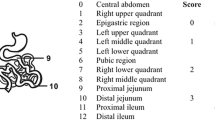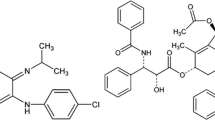Abstract
Purpose
The rationale for intraperitoneal (IP) chemotherapy is to expose peritoneal tumors to high drug concentrations. While multiple phase III trials have established the significant survival advantage by adding IP therapy to intravenous therapy in optimally debulked ovarian cancer patients, the use of IP chemotherapy is limited by the complications associated with indwelling catheters and by the local chemotherapy-related toxicity. The present study evaluated the effects of drug carrier on the disposition and efficacy of IP paclitaxel, for identifying strategies for further development of IP treatment.
Materials and Methods
Three paclitaxel formulations, i.e., Cremophor micelles, Cremophor-free paclitaxel-loaded gelatin nanoparticles and polymeric microparticles, were evaluated for peritoneal targeting advantage and antitumor activity in mice after IP injection. Whole body autoradiography and scanning electron microscopy were used to visualize the spatial drug distribution in tissues. A kinetic model, depicting the multiple processes involved in the peritoneal-to-plasma transfer of paclitaxel and its carriers, was established to determine the mechanisms by which a drug carrier alters the peritoneal targeting advantage.
Results
Autoradiographic results indicated that IP injection yielded much higher paclitaxel concentrations in intestinal tissues relative to intravenous injection. Compared to the Cremophor and nanoparticle formulations, the microparticles showed slower drug clearance from the peritoneal cavity, slower absorption into the systemic circulation, longer residence time, 10- to 45-times greater peritoneal targeting advantage and ∼2-times longer increase in survival time (p < 0.01 for all parameters).
Conclusions
Our results indicate the important roles of drug carrier in determining the peritoneal targeting advantage and antitumor activity of IP treatment.





Similar content being viewed by others
Abbreviations
- AUC:
-
area under curve
- AUMC:
-
area under moment curve
- HPLC:
-
high pressure liquid chromatography
- IP:
-
intraperitoneal
- MRT:
-
mean residence time
- MST:
-
median survival time
- PBS:
-
phosphate-buffered saline
- PLG:
-
poly(D,L-lactide-co-glycolide)
- SEM:
-
scanning electron microscope.
References
M. Markman, E. Rowinsky, T. Hakes, B. Reichman, W. Jones, J. L. Lewis, Jr., S. Rubin, J. Curtin, R. Barakat, M. Phillips, and Phase I trial of intraperitoneal taxol: a Gynecoloic Oncology Group study. J. Clin. Oncol. 10(9):1485–1491 (1992).
J. L. Speyer, J. M. Collins, R. L. Dedrick, M. F. Brennan, A. R. Buckpitt, H. Londer, V. T. DeVita, Jr., and C. E. Myers. Phase I and pharmacological studies of 5-fluorouracil administered intraperitoneally. Cancer Res. 40(3):567–572 (1980).
S. Zimm, S. M. Cleary, W. E. Lucas, R. J. Weiss, M. Markman, P. A. Andrews, M. A. Schiefer, S. Kim, C. Horton, and S. B. Howell. Phase I/pharmacokinetic study of intraperitoneal cisplatin and etoposide. Cancer Res. 47(6):1712–1716 (1987).
D. S. Alberts, P. Y. Liu, E. V. Hannigan, R. O’Toole, S. D. Williams, J. A. Young, E. W. Franklin, D. L. Clarke-Pearson, V. K. Malviya, and B. DuBeshter. Intraperitoneal cisplatin plus intravenous cyclophosphamide versus intravenous cisplatin plus intravenous cyclophosphamide for stage III ovarian cancer. N. Engl. J. Med. 335(26):1950–1955 (1996).
D. K. Armstrong, B. Bundy, L. Wenzel, H. Q. Huang, R. Baergen, S. Lele, L. J. Copeland, J. L. Walker, and R. A. Burger. Intraperitoneal cisplatin and paclitaxel in ovarian cancer. N. Engl. J. Med. 354(1):34–43 (2006).
A. Gadducci, F. Carnino, S. Chiara, I. Brunetti, L. Tanganelli, A. Romanini, M. Bruzzone, and P. F. Conte. Intraperitoneal versus intravenous cisplatin in combination with intravenous cyclophosphamide and epidoxorubicin in optimally cytoreduced advanced epithelial ovarian cancer: a randomized trial of the Gruppo Oncologico Nord-Ovest. Gynecol. Oncol. 76(2):157–162 (2000).
M. Markman, B. N. Bundy, D. S. Alberts, J. M. Fowler, D. L. Clark-Pearson, L. F. Carson, S. Wadler, and J. Sickel. Phase III trial of standard-dose intravenous cisplatin plus paclitaxel versus moderately high-dose carboplatin followed by intravenous paclitaxel and intraperitoneal cisplatin in small-volume stage III ovarian carcinoma: an intergroup study of the Gynecologic Oncology Group, Southwestern Oncology Group, and Eastern Cooperative Oncology Group. J. Clin. Oncol. 19(4):1001–1007 (2001).
A. Polyzos, N. Tsavaris, C. Kosmas, L. Giannikos, M. Katsikas, N. Kalahanis, G. Karatzas, K. Christodoulou, K. Giannakopoulos, D. Stamatiadis, and N. Katsilambros. A comparative study of intraperitoneal carboplatin versus intravenous carboplatin with intravenous cyclophosphamide in both arms as initial chemotherapy for stage III ovarian cancer. Oncology 56(4):291–296 (1999).
J. L. Walker, D. K. Armstrong, H. Q. Huang, J. Fowler, K. Webster, R. A. Burger, and D. Clarke-Pearson. Intraperitoneal catheter outcomes in a phase III trial of intravenous versus intraperitoneal chemotherapy in optimal stage III ovarian and primary peritoneal cancer: a Gynecologic Oncology Group Study. Gynecol. Oncol. 100(1):27–32 (2006).
M. S. Yen, C. M. Juang, C. R. Lai, G. C. Chao, H. T. Ng, and C. C. Yuan. Intraperitoneal cisplatin-based chemotherapy vs. intravenous cisplatin-based chemotherapy for stage III optimally cytoreduced epithelial ovarian cancer. Int. J. Gynaecol. Obstet. 72(1):55–60 (2001).
E. de Bree, P. A. Theodoropoulos, H. Rosing, J. Michalakis, J. Romanos, J. H. Beijnen, and D. D. Tsiftsis. Treatment of ovarian cancer using intraperitoneal chemotherapy with taxanes: from laboratory bench to bedside. Cancer Treat. Rev. 32(6):471–482 (2006).
http://www.cancer.gov/newscenter/pressreleases/IPchemotherapyrelease.
K. B. Goldberg. Phase III Trial shows benefit for old drug, device, for ovarian cancer; will practice change? Cancer Lett. 32(2):1–4 (2006).
V. K. Malviya, G. Deppe, G. Boike, and J. Young. Pharmacokinetics of intraperitoneal doxorubicin in combination with systemic cyclophosphamide and cis-platinum in the treatment of stage III ovarian cancer. Gynecol. Oncol. 36(2):185–188 (1990).
P. J. O’Dwyer, F. LaCreta, M. Hogan, N. Rosenblum, J. L. O’Dwyer, and R. L. Comis. Pharmacologic study of etoposide and cisplatin by the intraperitoneal route. J. Clin. Pharmacol. 31(3):253–258 (1991).
H. Gelderblom, J. Verweij, D. M. van Zomeren, D. Buijs, L. Ouwens, K. Nooter, G. Stoter, and A. Sparreboom. Influence of Cremophor El on the bioavailability of intraperitoneal paclitaxel. Clin. Cancer Res. 8(4):1237–1241 (2002).
K. Yokogawa, M. Jin, N. Furui, M. Yamazaki, H. Yoshihara, M. Nomura, H. Furukawa, J. Ishizaki, S. Fushida, K. Miwa, and K. Miyamoto. Disposition kinetics of taxanes after intraperitoneal administration in rats and influence of surfactant vehicles. J. Pharm. Pharmacol. 56(5):629–634 (2004).
I. Knemeyer, M. G. Wientjes, and J. L. Au. Cremophor reduces paclitaxel penetration into bladder wall during intravesical treatment. Cancer Chemother. Pharmacol. 44(3):241–248 (1999).
W. J. Gradishar, S. Tjulandin, N. Davidson, H. Shaw, N. Desai, P. Bhar, M. Hawkins, and J. O’Shaughnessy. Phase III trial of nanoparticle albumin-bound paclitaxel compared with polyethylated castor oil-based paclitaxel in women with breast cancer. J. Clin. Oncol. 23(31):7794–7803 (2005).
M. Harries, P. Ellis, and P. Harper. Nanoparticle albumin-bound paclitaxel for metastatic breast cancer. J. Clin. Oncol. 23(31):7768–7771 (2005).
A. Sparreboom, C. D. Scripture, V. Trieu, P. J. Williams, T. De, A. Yang, B. Beals, W. D. Figg, M. Hawkins, and N. Desai. Comparative preclinical and clinical pharmacokinetics of a cremophor-free, nanoparticle albumin-bound paclitaxel (ABI-007) and paclitaxel formulated in Cremophor (Taxol). Clin. Cancer Res. 11(11):4136–4143 (2005).
T. K. Yeh, Z. Lu, M. G. Wientjes, and J. L. Au. Formulating paclitaxel in nanoparticles alters its disposition. Pharm. Res. 22(6):867–874 (2005).
G. J. Fetterly and R. M. Straubinger. Pharmacokinetics of paclitaxel-containing liposomes in rats. AAPS PharmSci. 5(4):E32 (2003).
S. Natsugoe, K. Tokuda, M. Shimada, T. Kumanohoso, M. Baba, S. Takao, M. Tabata, K. Nakamura, H. Yoshizawa, and T. Aikou. Morphology of the designed biodegradable cisplatin microsphere. Anticancer Res. 19(6B):5163–5167 (1999).
A. Hagiwara, T. Takahashi, K. Sawai, C. Sakakura, H. Tsujimoto, T. Imanishi, M. Ohgaki, J. Yamazaki, S. Muranishi, A. Yamamoto, and T. Fujita. Pharmacological effects of 5-fluorouracil microspheres on peritoneal carcinomatosis in animals. Br. J. Cancer 74(9):1392–1396 (1996).
D. K. Armstrong, G. F. Fleming, M. Markman, and H. H. Bailey. A phase I trial of intraperitoneal sustained-release paclitaxel microspheres (Paclimer) in recurrent ovarian cancer: a Gynecologic Oncology Group study. Gynecol. Oncol. 103(2):391–396 (2006).
L. Gianni, C. M. Kearns, A. Giani, G. Capri, L. Vigano, A. Lacatelli, G. Bonadonna, and M. J. Egorin. Nonlinear pharmacokinetics and metabolism of paclitaxel and its pharmacokinetic/pharmacodynamic relationships in humans. J. Clin. Oncol. 13(1):180–190 (1995).
C. M. Kearns. Pharmacokinetics of the taxanes. Pharmacotherapy 17(5 Pt 2):105S–109S (1997).
Z. Lu, T. K. Yeh, M. Tsai, J. L. Au, and M. G. Wientjes. Paclitaxel-loaded gelatin nanoparticles for intravesical bladder cancer therapy. Clin. Cancer Res. 10(22):7677–7684 (2004).
S. Ullberg and B. Larsson. Whole-body autoradiography. Methods Enzymol. 77:64–80 (1981).
D. Song and J. L. Au. Isocratic high-performance liquid chromatographic assay of taxol in biological fluids and tissues using automated column switching. J. Chromatogr. B Biomed. Appl. 663(2):337–344 (1995).
D. Chen, D. Song, M. G. Wientjes, and J. L. Au. Effect of dimethyl sulfoxide on bladder tissue penetration of intravesical paclitaxel. Clin. Cancer Res. 9(1):363–369 (2003).
M. A. Baron. Structure of the intestinal peritoneum in man. Am. J. Anat. 69(3):439–497 (1941).
M. F. Flessner, J. D. Fenstermacher, R. G. Blasberg, and R. L. Dedrick. Peritoneal absorption of macromolecules studied by quantitative autoradiography. Am. J. Physiol. 248(1 Pt 2):H26–H32 (1985).
W. J. Shih, J. J. Coupal, and H. L. Chia. Communication between peritoneal cavity and mediastinal lymph nodes demonstrated by Tc-99m albumin nanocolloid intraperitoneal injection. Proc. Natl. Sci. Counc. Repub. China B 17(3):103–105 (1993).
K. Hirano and C. A. Hunt. Lymphatic transport of liposome-encapsulated agents: effects of liposome size following intraperitoneal administration. J. Pharm. Sci. 74(9):915–921 (1985).
B. Monsarrat, P. Alvinerie, M. Wright, J. Dubois, F. Gueritte-Voegelein, D. Guenard, R. C. Donehower, and E. K. Rowinsky. Hepatic metabolism and biliary excretion of Taxol in rats and humans. J. Natl. Cancer Inst. Monogr. 15:39–46 (1993).
K. Nishida, A. Kuma, S. Fumoto, M. Nakashima, H. Sasaki, and J. Nakamura. Absorption characteristics of model compounds from the small intestinal serosal surface and a comparison with other organ surfaces. J. Pharm. Pharmacol. 57(8):1073–1077 (2005).
K. Waxman, M. H. Soliman, and K. H. Nguyen. Absorption of insulin in the peritoneal cavity in a diabetic animal model. Artif. Organs 17(11):925–928 (1993).
A. Sharma, U. S. Sharma, and R. M. Straubinger. Paclitaxel-liposomes for intracavitary therapy of intraperitoneal P388 leukemia. Cancer Lett. 107(2):265–272 (1996).
Acknowledgements
This work was supported in part by a research grant R37CA49816 and R43CA103133 from the National Cancer Institute, NIH, DHHS.
Author information
Authors and Affiliations
Corresponding author
Rights and permissions
About this article
Cite this article
Tsai, M., Lu, Z., Wang, J. et al. Effects of Carrier on Disposition and Antitumor Activity of Intraperitoneal Paclitaxel. Pharm Res 24, 1691–1701 (2007). https://doi.org/10.1007/s11095-007-9298-0
Received:
Accepted:
Published:
Issue Date:
DOI: https://doi.org/10.1007/s11095-007-9298-0




